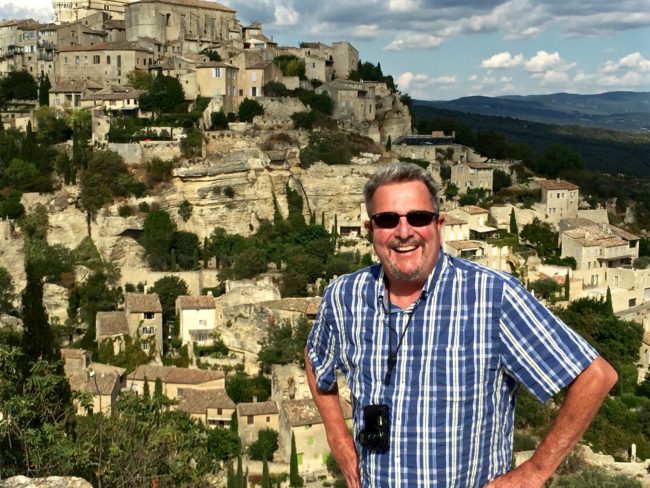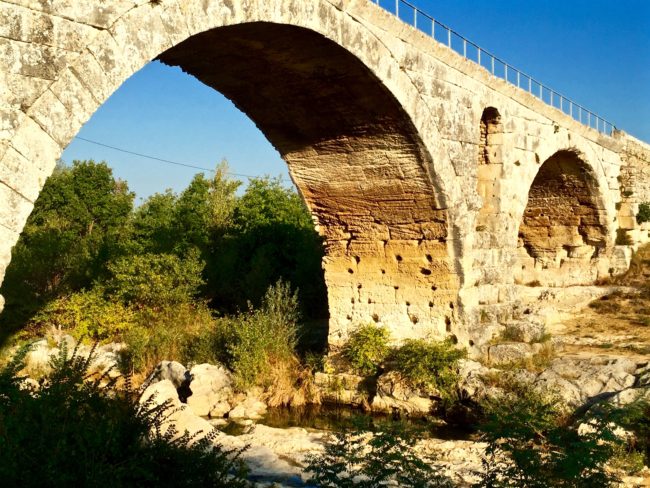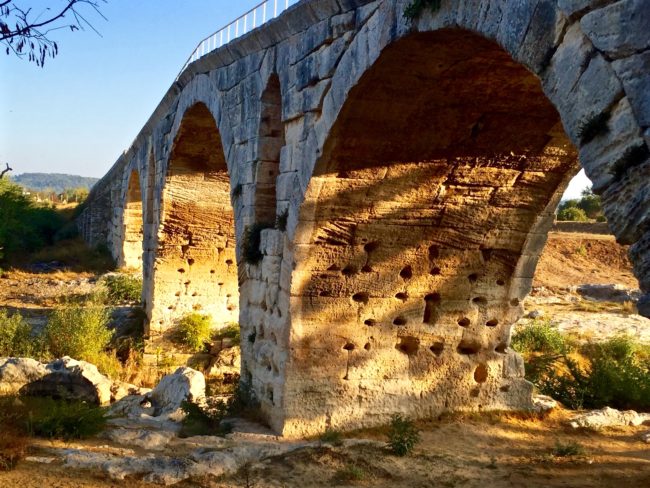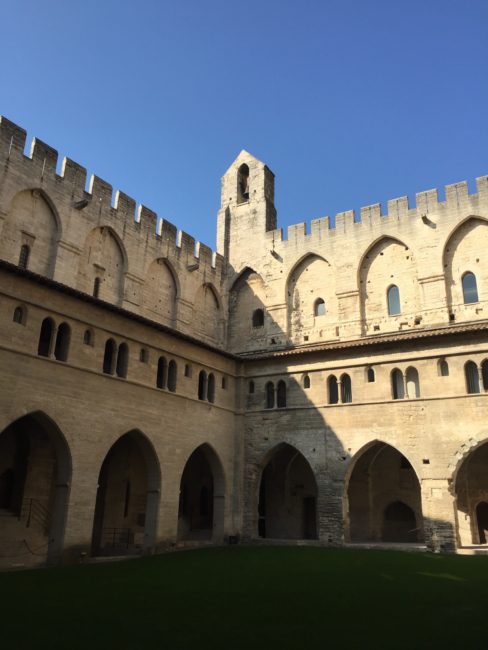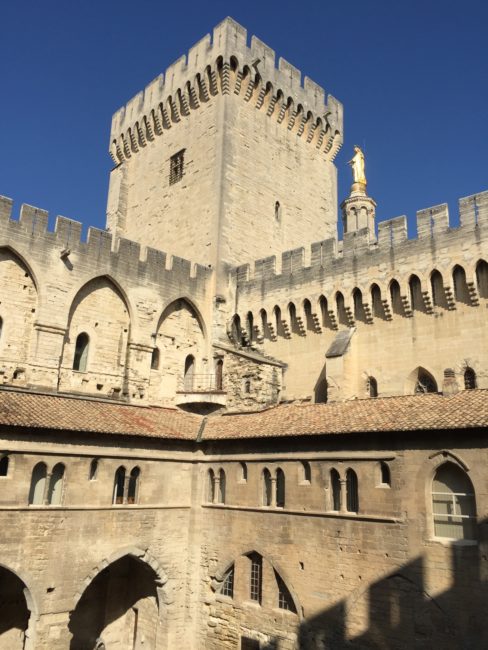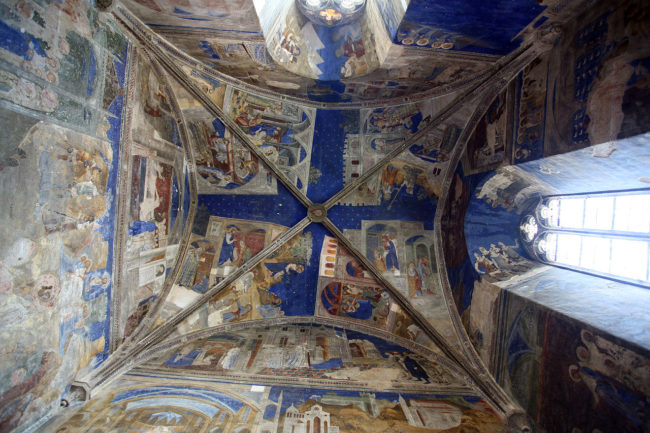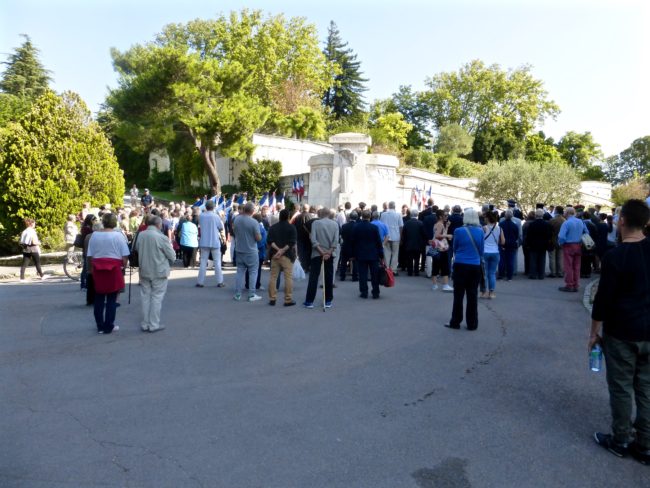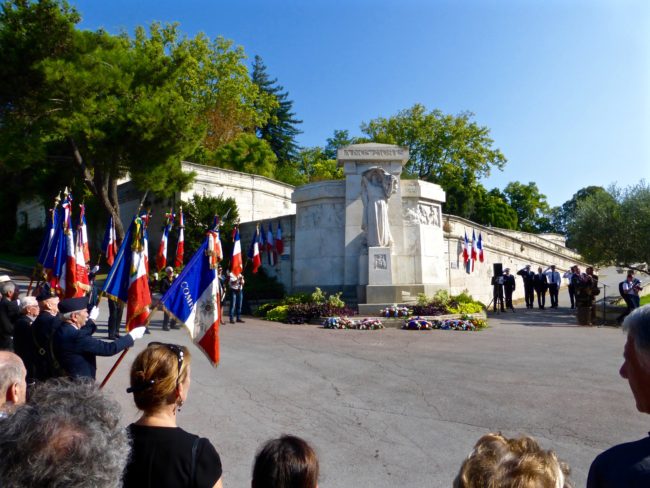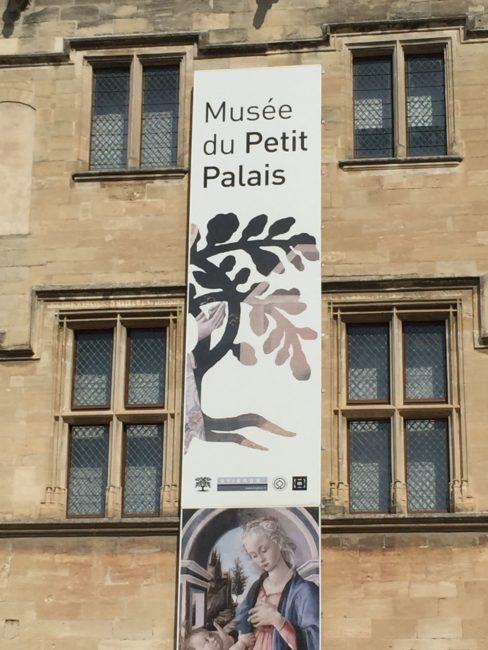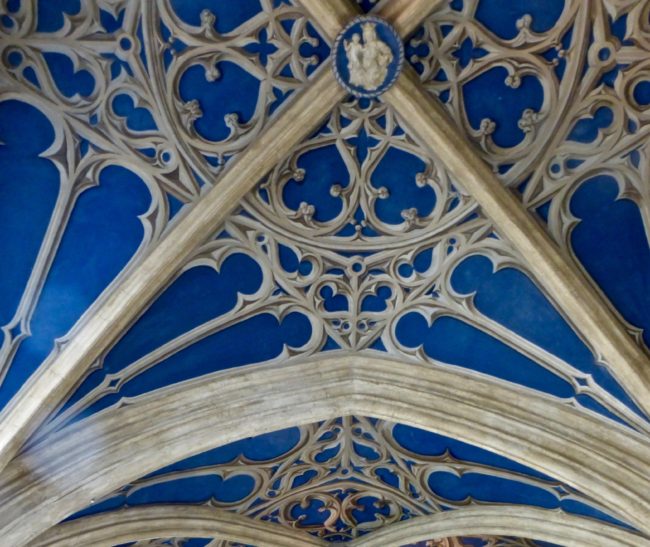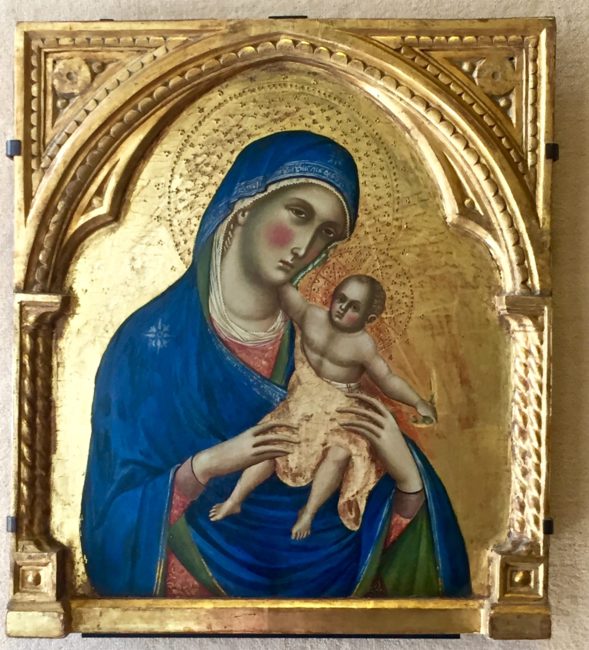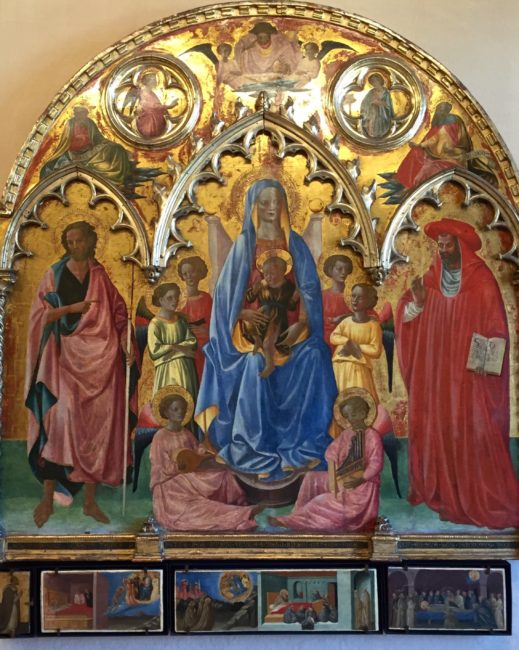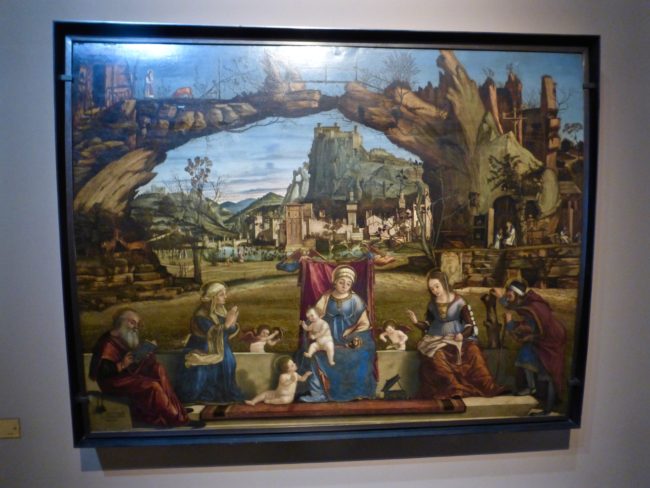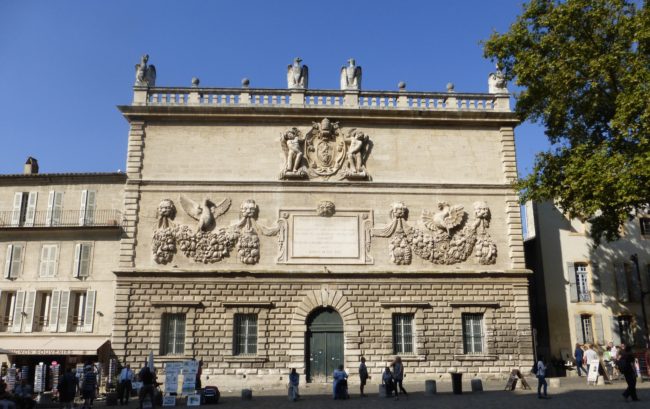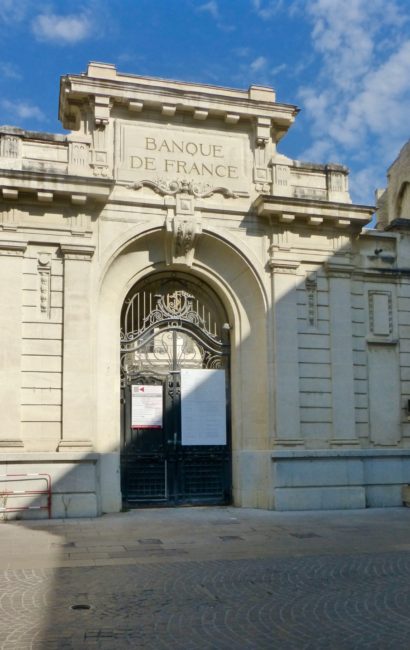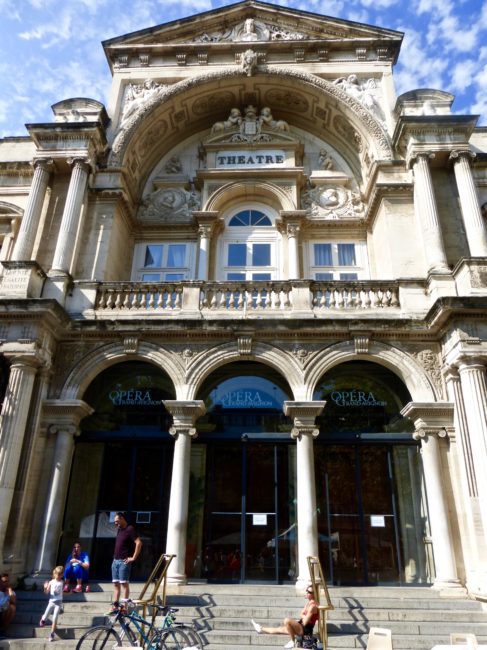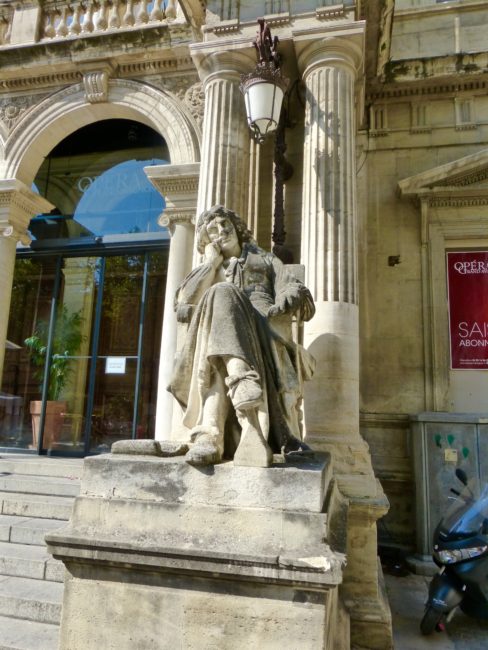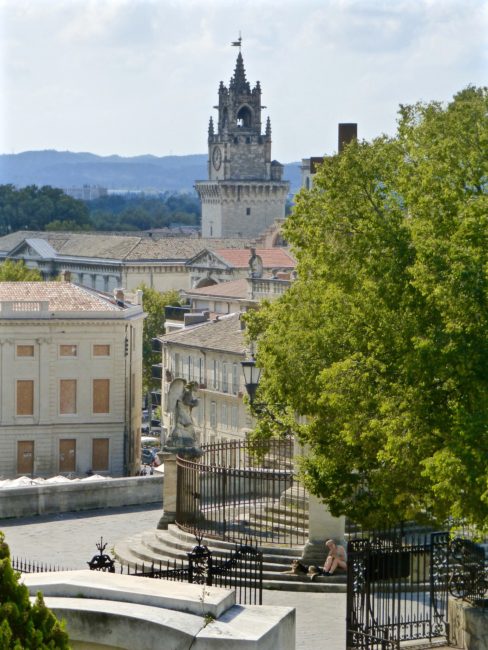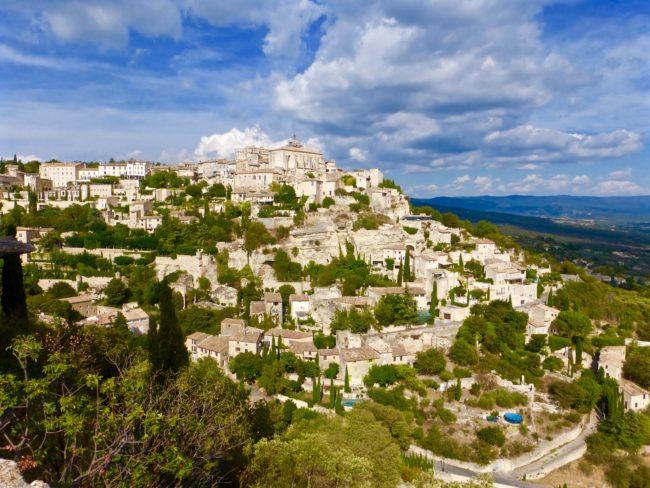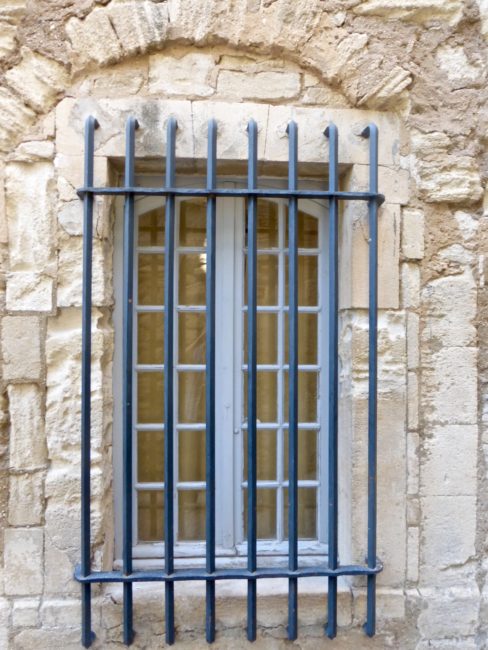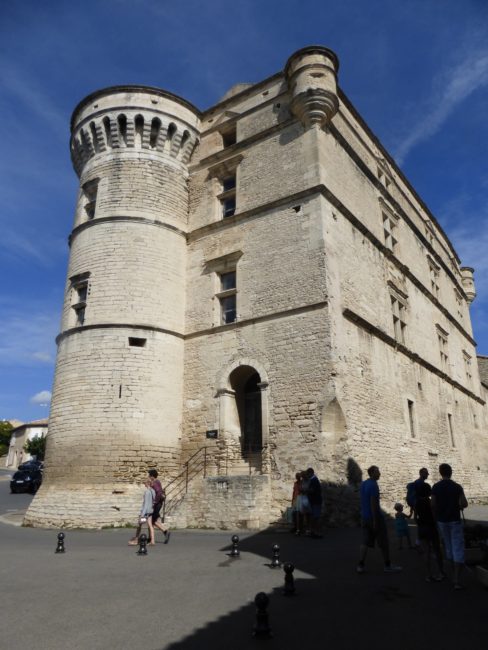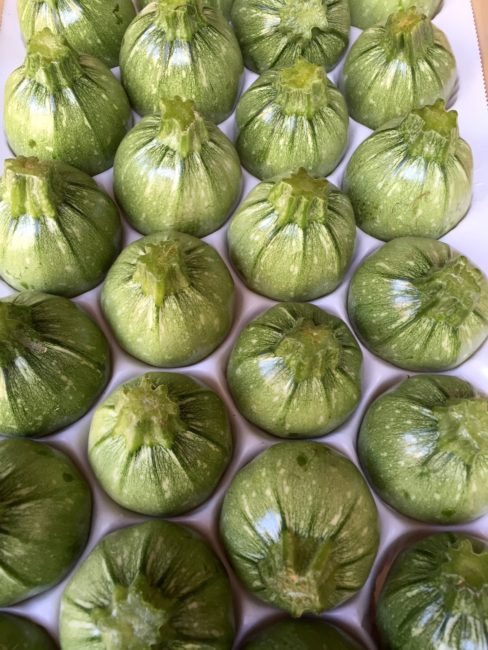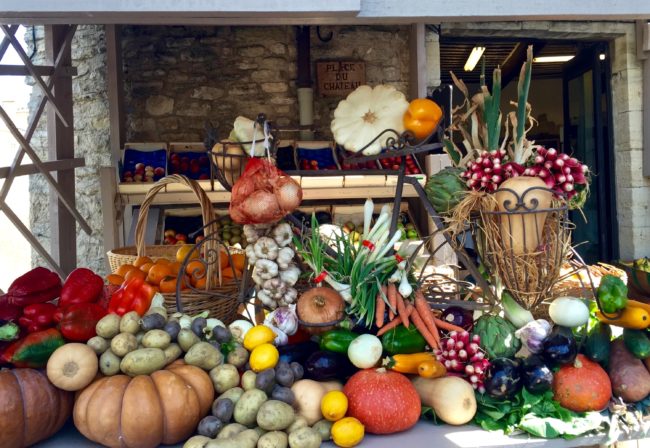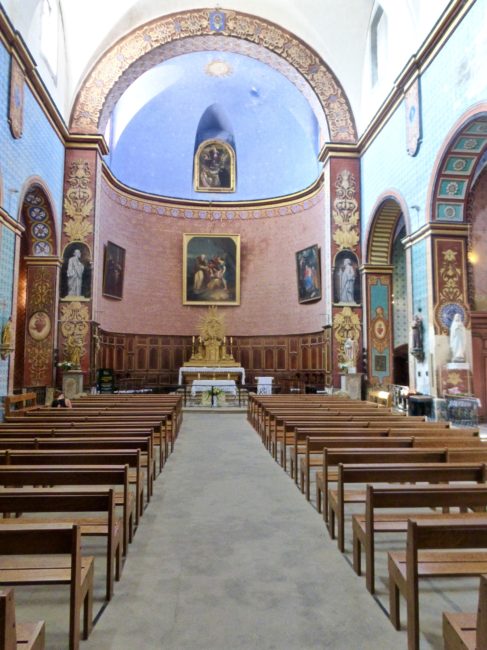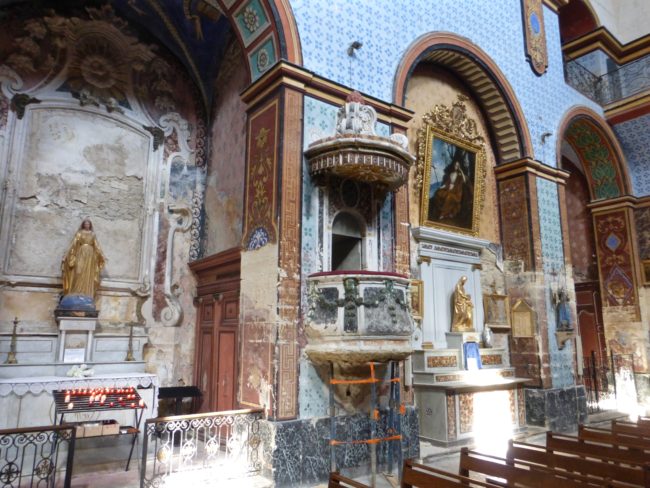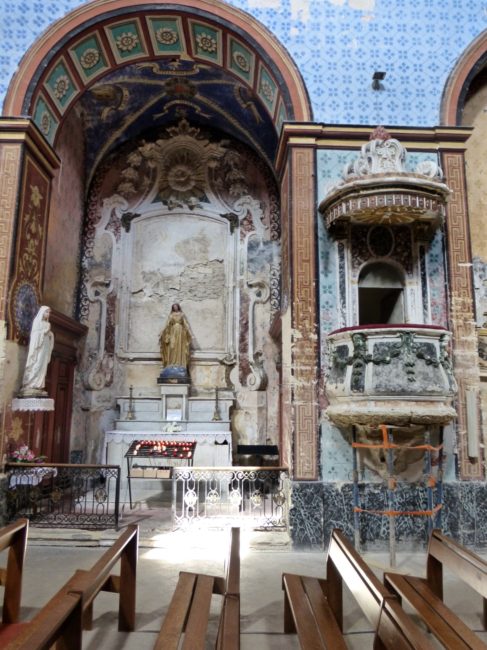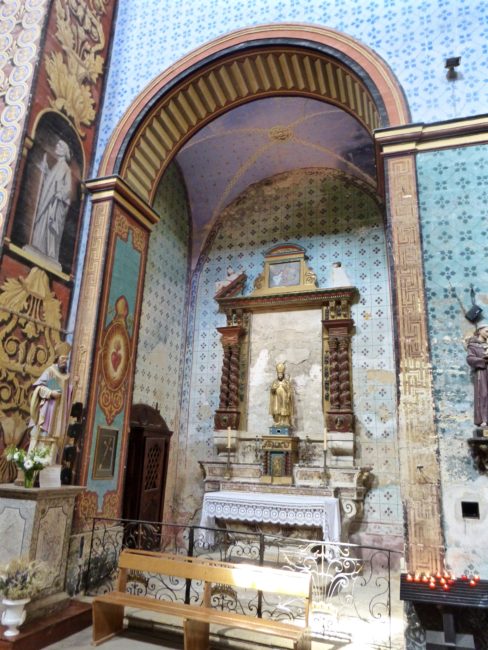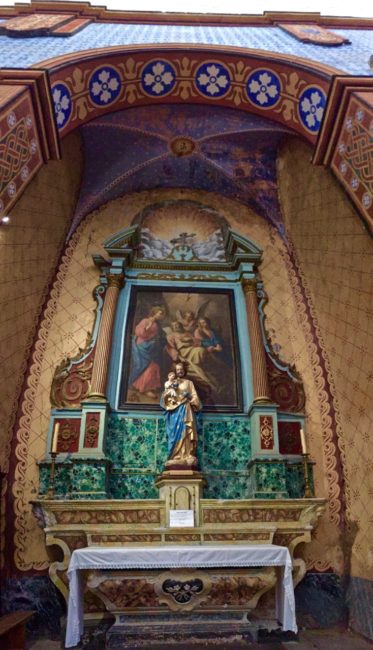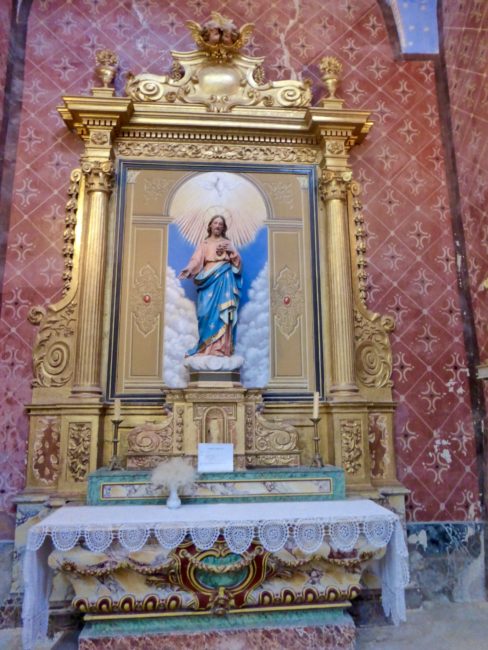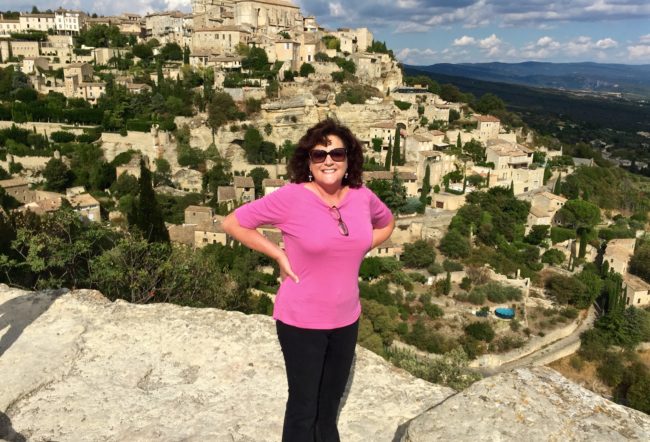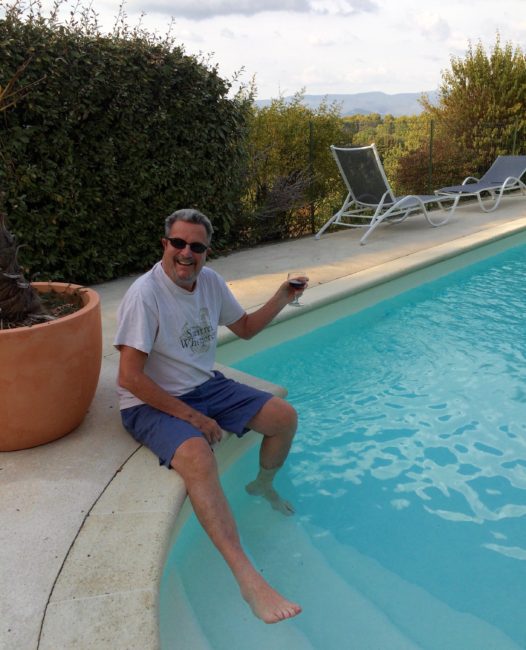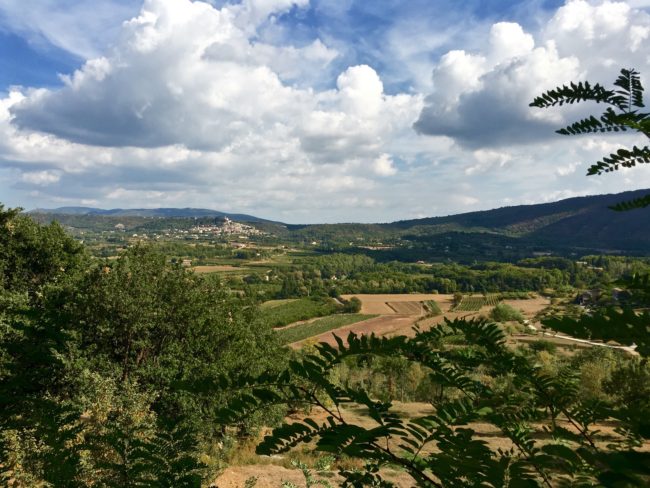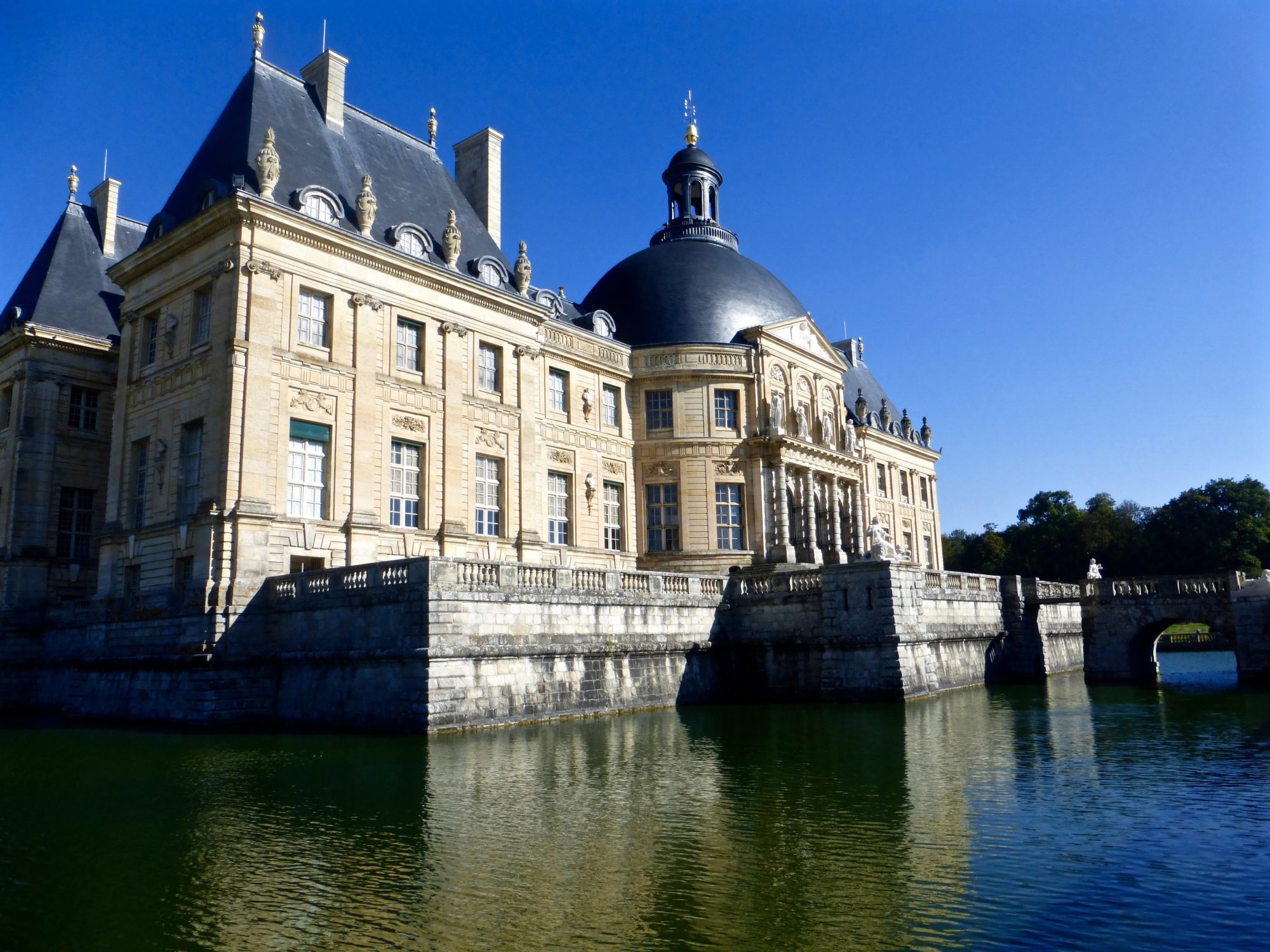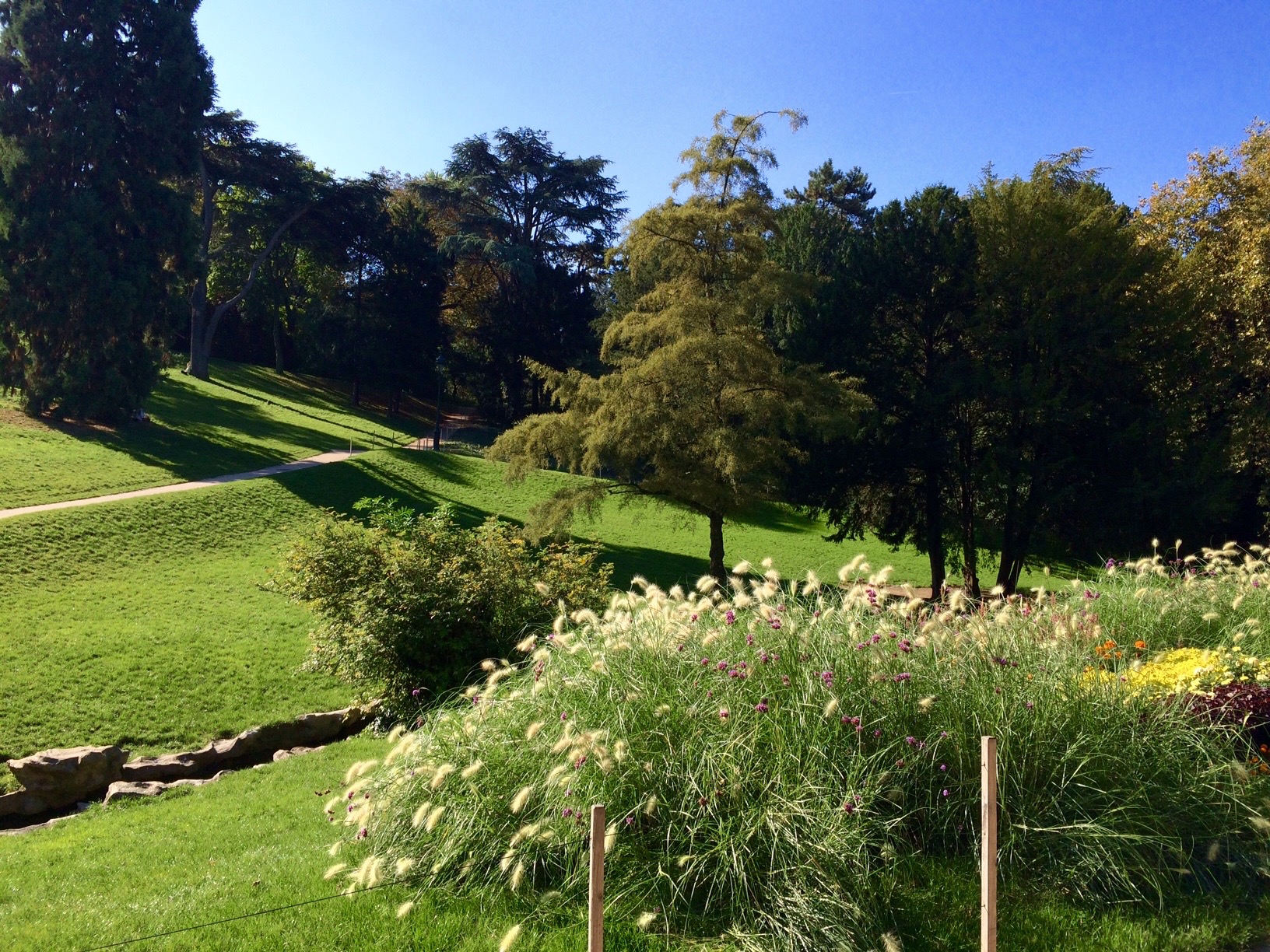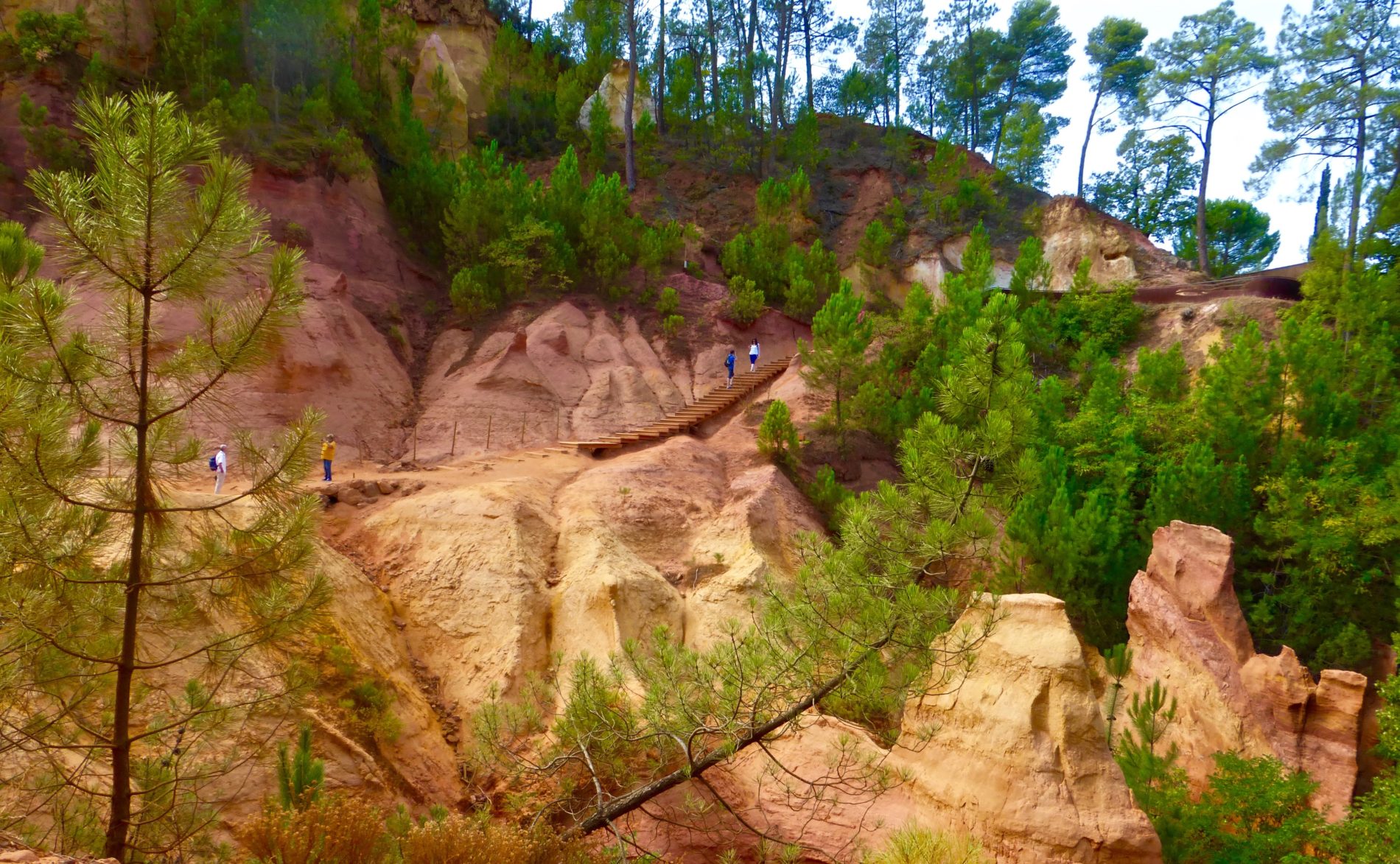
Chapter Six: Looping The Lovely Luberon
November 29, 2016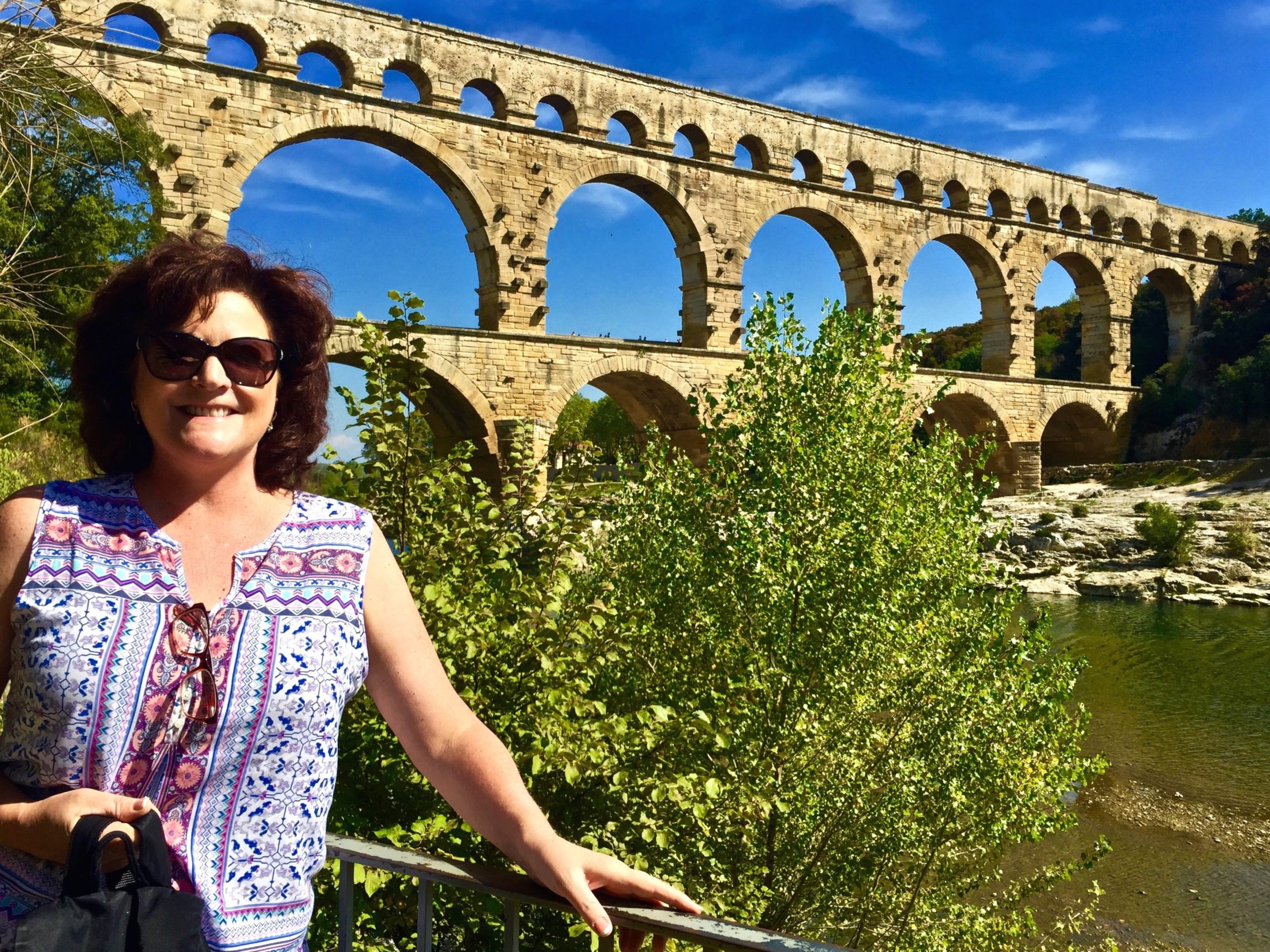
Chapter Eight: Waterwheels, On Gard & Uzés
December 21, 2016Chapter Seven: Old Bridge, Old Popes, Old Town, Old Man!
Day Seven – Pont Diversion, Papes Goes The Palace, A Tour We Could Have Skipped, Stop All These Weddings, Solemn Ceremony, How Art Thou, A Bridge Too Far…and Too Short, Going Out Of My Gordes, Better From The Road, Lavender-less Abbey, Does The Gift Store Have a Defibrillator, Tracy Takes The Wheel, More Deserted Hill Towns and Dinner Is Not For Nil
Our last day in Provence…On a picture-perfect Sunday morning, we had a quick breakfast because we were going to the big city; well, a bigger city anyway…Avignon. Tracy and I had paid a quick visit to Avignon in 1998, and truthfully the only thing I remembered about it was walking out on a bridge and almost falling off because the damned thing stops in the middle of a river.
We drove past the lovely parish church of Bonnieux…
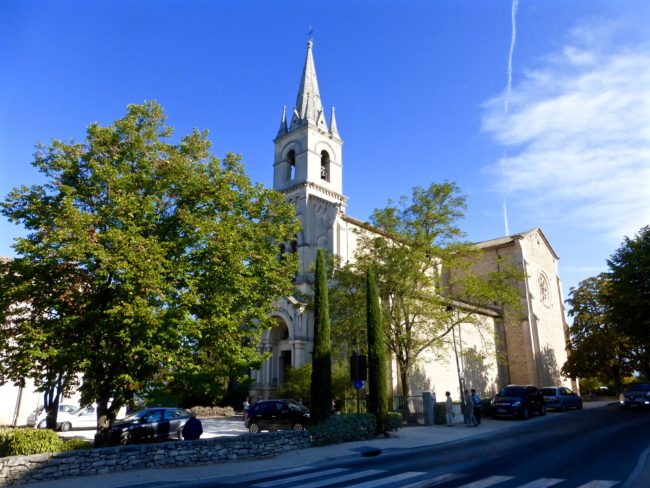 …and headed into the countryside on our way to Avignon…
…and headed into the countryside on our way to Avignon…
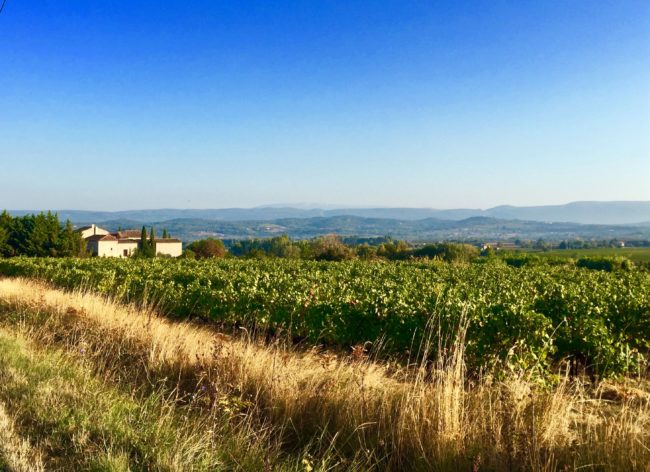 …but first we had a detour to make. I had wanted to see Le Pont Julien, a bridge built by the Romans around 3 BC. The “BC” must have meant “Before Cement,” because this bridge was not cemented with any mortar, “so masons had to carefully assemble blocks to perfectly interlock with each other.” Those are the concrete facts.
…but first we had a detour to make. I had wanted to see Le Pont Julien, a bridge built by the Romans around 3 BC. The “BC” must have meant “Before Cement,” because this bridge was not cemented with any mortar, “so masons had to carefully assemble blocks to perfectly interlock with each other.” Those are the concrete facts.
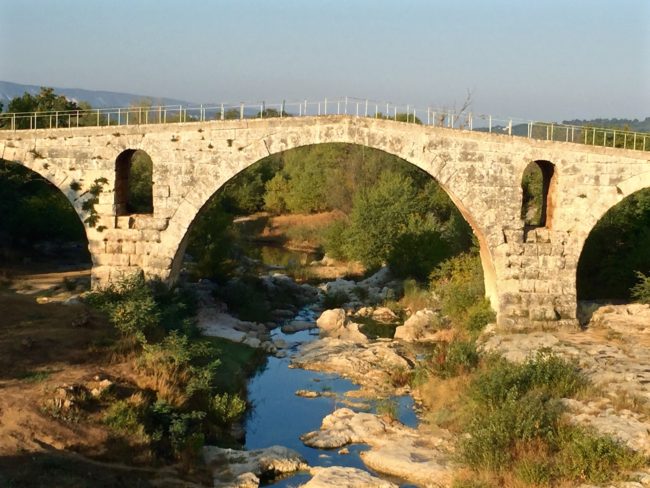 It was a gorgeous morning, so much so that the only other person there was a professional photographer (I could tell, because his camera couldn’t fit in his pocket like mine).
It was a gorgeous morning, so much so that the only other person there was a professional photographer (I could tell, because his camera couldn’t fit in his pocket like mine).
He said he had visited this spot on many occasions, and this was the best light he had ever seen. Although probably not as good as his, Tracy captured some nice photos on her iPhone.
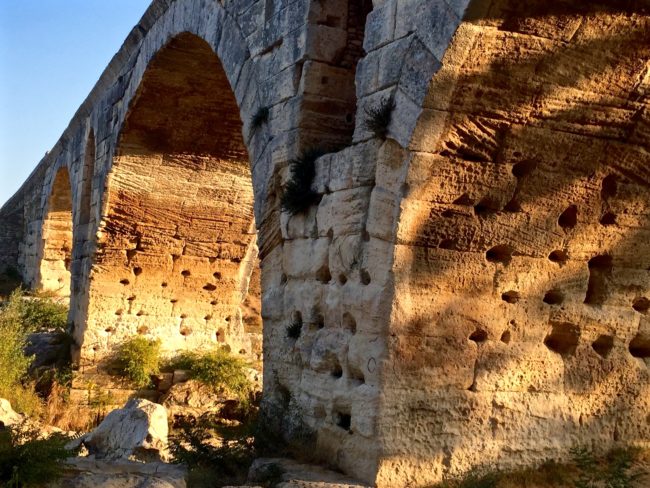 After about 15 minutes, we were back on the road in search of Avignon, which became the seat of the Papacy for about 70 years in the 14th century, starting when Pope Clement V decided to skedaddle from Rome (too many tourists). In any event, seven popes called Avignon home, and the third one, Benedict XII (even though they were in France they continued with the Roman numerals), is the pope who was responsible for the building of one of the most famous Christian palaces in the world, the Palais des Papes. It’s also one of the largest Gothic structures in the world.
After about 15 minutes, we were back on the road in search of Avignon, which became the seat of the Papacy for about 70 years in the 14th century, starting when Pope Clement V decided to skedaddle from Rome (too many tourists). In any event, seven popes called Avignon home, and the third one, Benedict XII (even though they were in France they continued with the Roman numerals), is the pope who was responsible for the building of one of the most famous Christian palaces in the world, the Palais des Papes. It’s also one of the largest Gothic structures in the world.
I hope the future popes had an easier time getting through Avignon, because after making a wrong turn, I felt a little lost. My navigator in chief, Tracy, using her vast knowledge and power of observation said (I believe it might have been sarcastically), “I think if you follow that giant wall long enough, we’ll find a place to park,” and soon, of course, we did (parking was €6).
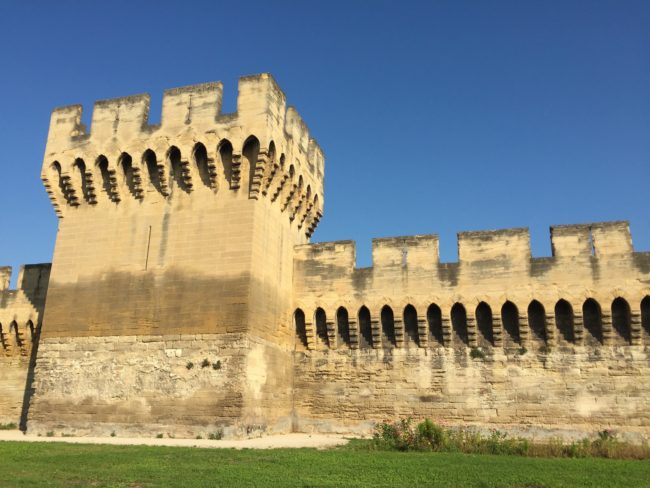 Looming ahead (with a church on its left) as we popped out of the lot…
Looming ahead (with a church on its left) as we popped out of the lot…
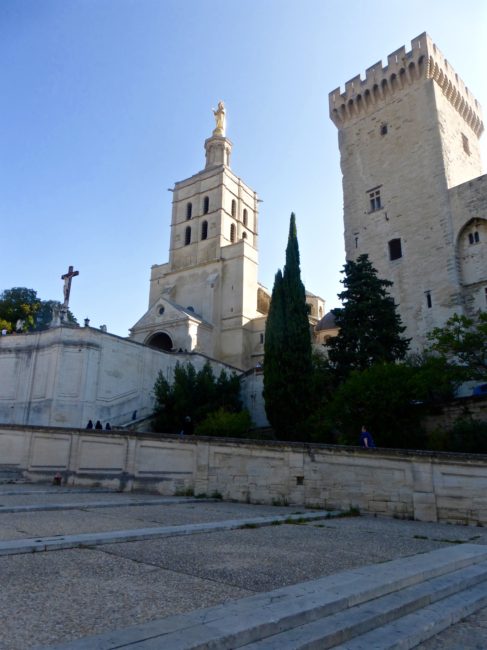 …there stood a huge edifice that could only be our destination. I asked Tracy if we had visited here in 1998, and she said, “I think so.” I couldn’t remember. After visiting, I could see why.
…there stood a huge edifice that could only be our destination. I asked Tracy if we had visited here in 1998, and she said, “I think so.” I couldn’t remember. After visiting, I could see why.
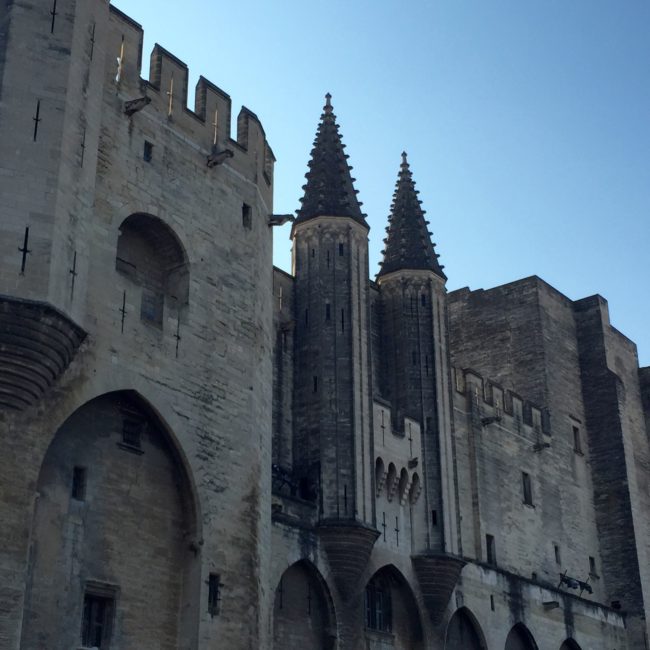 Before I am accused of blasphemy, I will admit that the history provided by the audio guides (€2 apiece) was fascinating, and it is a UNESCO World Heritage Site, so we could get our “make-believe” UNESCO card stamped.
Before I am accused of blasphemy, I will admit that the history provided by the audio guides (€2 apiece) was fascinating, and it is a UNESCO World Heritage Site, so we could get our “make-believe” UNESCO card stamped.
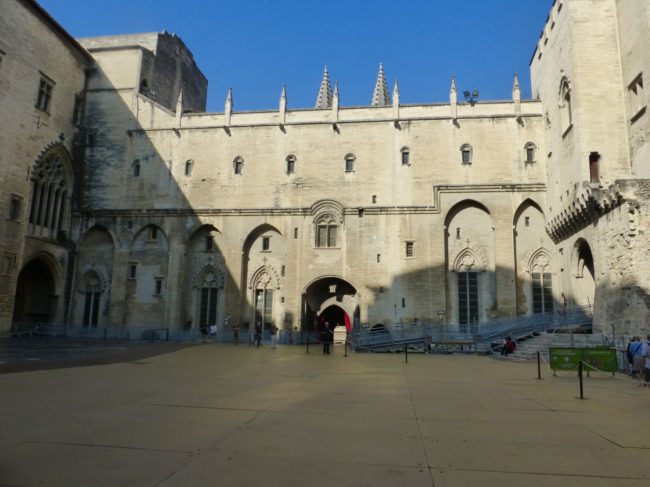 After paying our €11 entry fee we entered into a courtyard.
After paying our €11 entry fee we entered into a courtyard.
Afterward, we stepped inside the palace. Thanks to those darned revolutionaries back in the late 1700s, the palace was stripped of most anything interesting. It didn’t help that it was further damaged by the Third Republic.
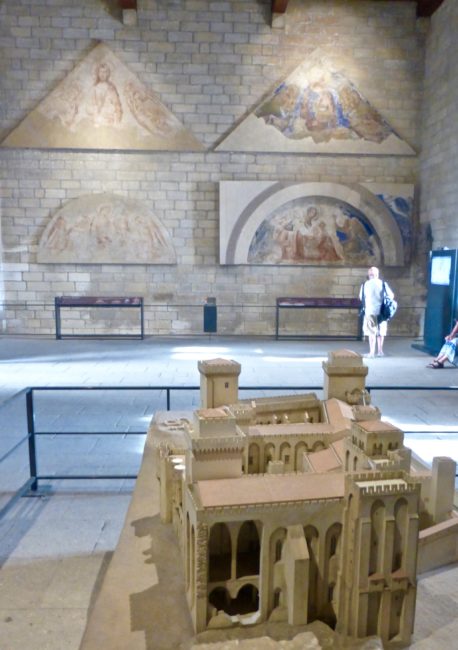 At one time, the frescoes covering many of the walls were some of the finest in the world.
At one time, the frescoes covering many of the walls were some of the finest in the world.
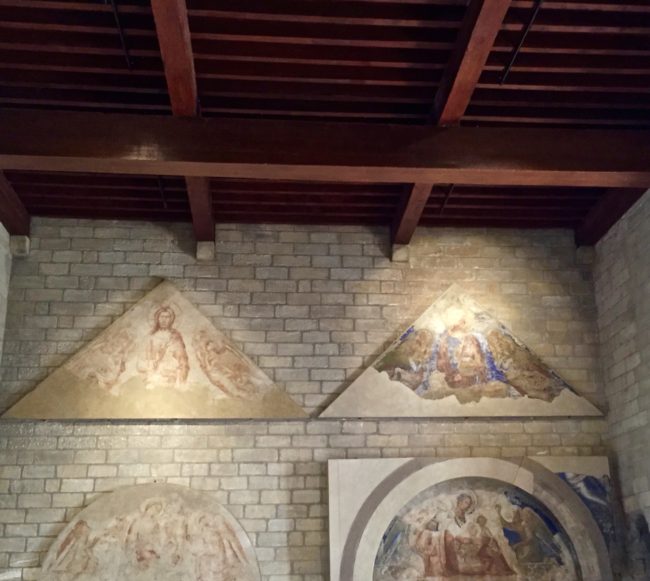 The Grand Tinal Banquet Hall contained an arched ceiling that looked like an upside down boat.
The Grand Tinal Banquet Hall contained an arched ceiling that looked like an upside down boat.
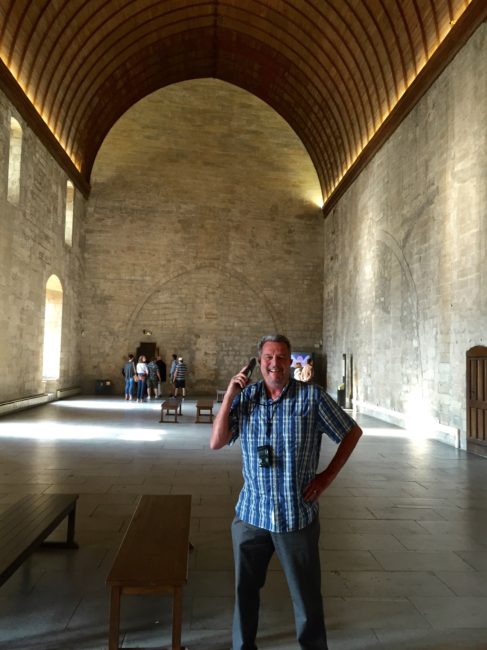 We walked into one room that was mostly ruins. Remembering how much Tracy likes ruins, we quickly exited that room.
We walked into one room that was mostly ruins. Remembering how much Tracy likes ruins, we quickly exited that room.
 I think this guy is Pope Benedict XII (whose egg dish I still love today), but don’t hold me to that.
I think this guy is Pope Benedict XII (whose egg dish I still love today), but don’t hold me to that.
 Some important people from the time of papal rule in Avignon seemed to be plastered in the North Sacristy.
Some important people from the time of papal rule in Avignon seemed to be plastered in the North Sacristy.
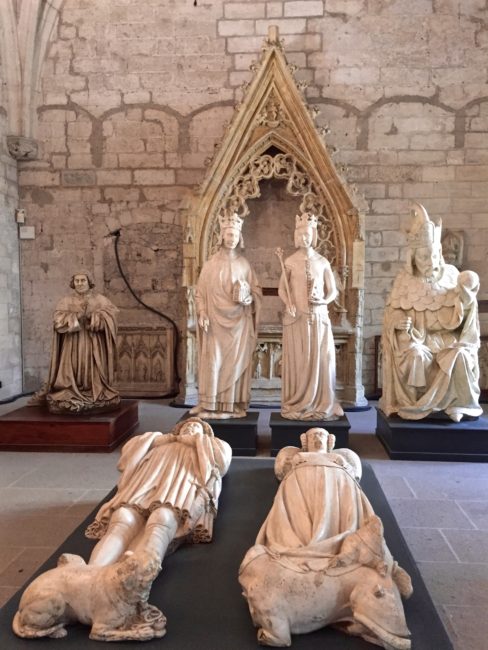 There was also a reproduction of Pope Gregory XI, who eventually moved the court back to Rome in 1377 (I believe he was a big cacio e pepe fan and missed his favorite dish).
There was also a reproduction of Pope Gregory XI, who eventually moved the court back to Rome in 1377 (I believe he was a big cacio e pepe fan and missed his favorite dish).
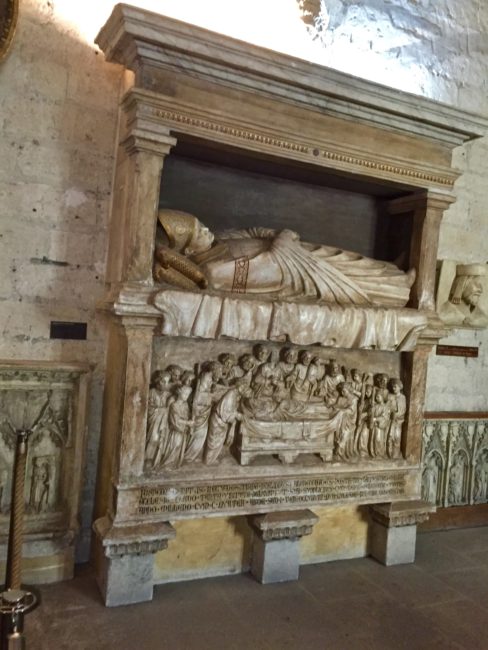 Although a little tired on this morning, I decided not to take a seat in the massive fireplace. You never know.
Although a little tired on this morning, I decided not to take a seat in the massive fireplace. You never know.
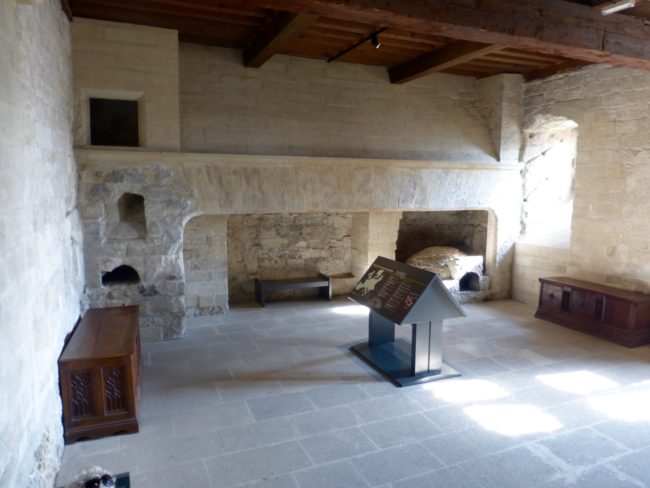 There was a beautiful bas relief of The Passion Of The Christ that was better than the Mel Gibson movie.
There was a beautiful bas relief of The Passion Of The Christ that was better than the Mel Gibson movie.
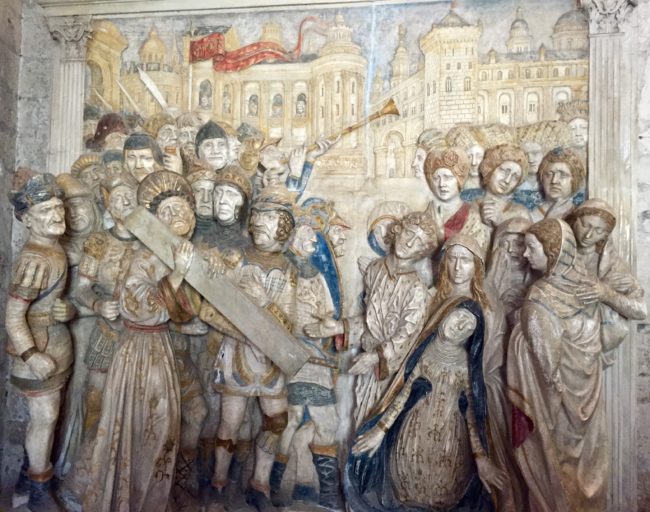 There were some once gorgeous frescoes (still beautiful to see) in the Chapelle de saint Martial. These were done by Matteo Giovannetti, but since no photos were allowed (“Martial law”), I “borrowed” these photos from wikipedia.
There were some once gorgeous frescoes (still beautiful to see) in the Chapelle de saint Martial. These were done by Matteo Giovannetti, but since no photos were allowed (“Martial law”), I “borrowed” these photos from wikipedia.
Before leaving we passed under arches that included religious figures whose heads were lopped off by tick-off revolutionaries.
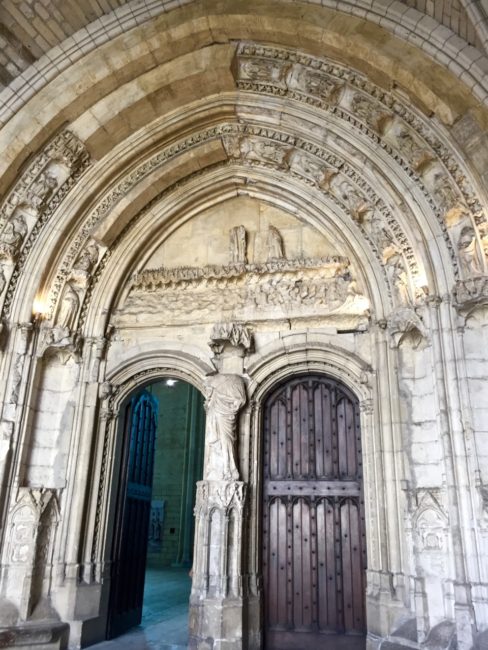 Many tourists standing nearby wouldn’t have minded this guy be beheaded.
Many tourists standing nearby wouldn’t have minded this guy be beheaded.
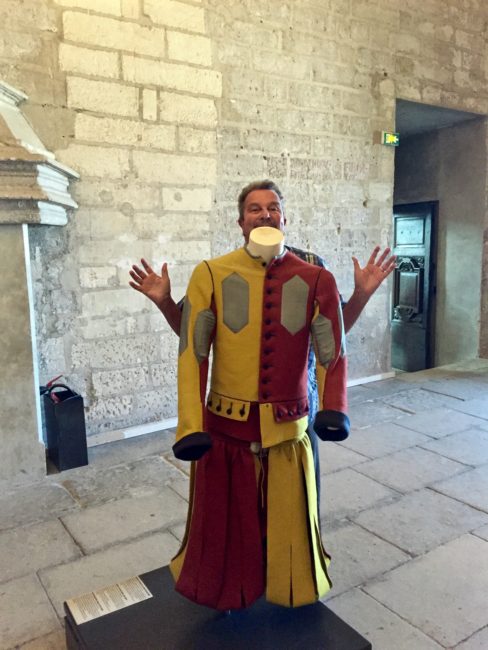 Back outside, I passed by this musician, took his photo and paid him accordionly…
Back outside, I passed by this musician, took his photo and paid him accordionly…
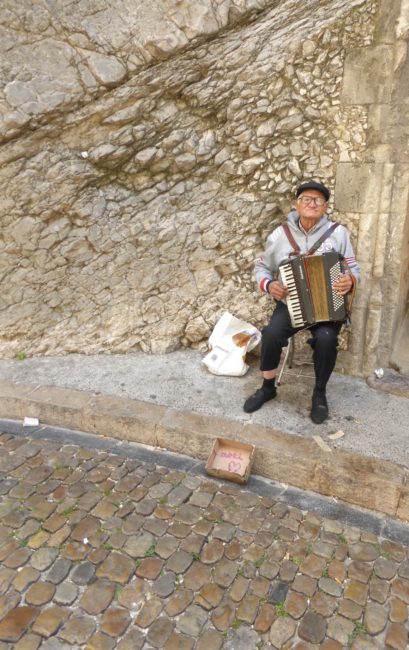 …and we were back in the square.
…and we were back in the square.
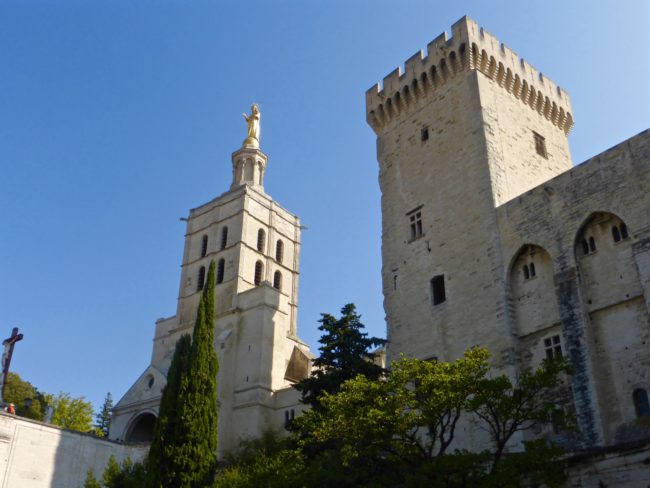 We took the innumerable steps up to Cathédrale Notre Dame-des-Doms, where the doors were just closing for a wedding. Having been in Kim and Mary’s Catholic wedding, I knew it wouldn’t probably end until Tuesday, so we moved on.
We took the innumerable steps up to Cathédrale Notre Dame-des-Doms, where the doors were just closing for a wedding. Having been in Kim and Mary’s Catholic wedding, I knew it wouldn’t probably end until Tuesday, so we moved on.
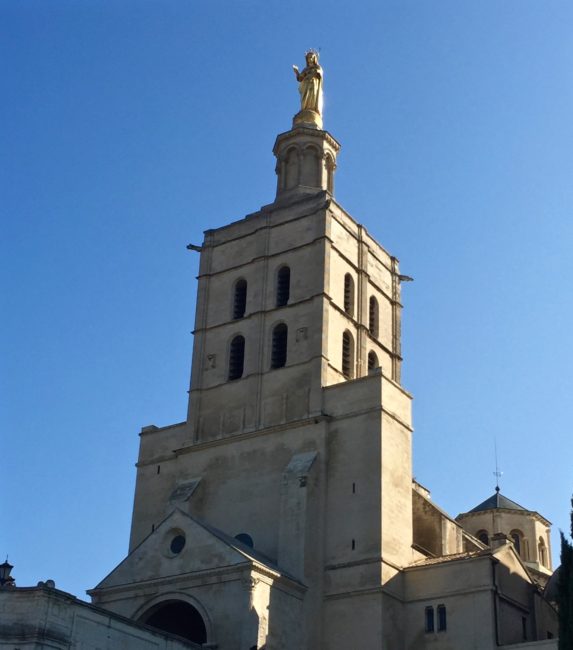 Very near the church and the entrance to Jardin du Rocher-des-Doms, a ceremony was being held that I assumed was to honor World War II dead. That’s because the dates 1939 and 1945 flanked a statue with the words “Anos Morts” above it. Below the statues were wreaths with French flags further to the right.
Very near the church and the entrance to Jardin du Rocher-des-Doms, a ceremony was being held that I assumed was to honor World War II dead. That’s because the dates 1939 and 1945 flanked a statue with the words “Anos Morts” above it. Below the statues were wreaths with French flags further to the right.
In a Casablanca moment, La Marseillaise started to play, and Tracy set her iPhone to record this somber, yet at the same time uplifting, moment. At the end, she realized she had pushed the wrong button (good photographer; bad videographer).
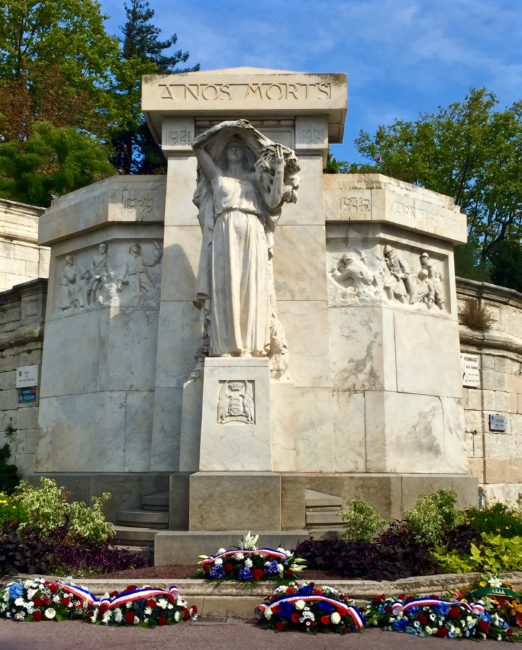 Located relatively nearby (back down the steps) was the Musée du Petit Palais (€6). We checked out the ceiling upon entering.
Located relatively nearby (back down the steps) was the Musée du Petit Palais (€6). We checked out the ceiling upon entering.
It houses a collection of 13th to 16th century Italian religious paintings.
We didn’t stay too long because…
…our minds were diverted to food. Walking past some historic buildings, there was also some kind of fair going on with music blaring (damn kids today)…
…but, after passing by the theatre, we finally found a spot near Place de L’Horloge (called the “social nerve center” of Avignon) to dine al fresco.
After lunch, we walked back through Avignon…
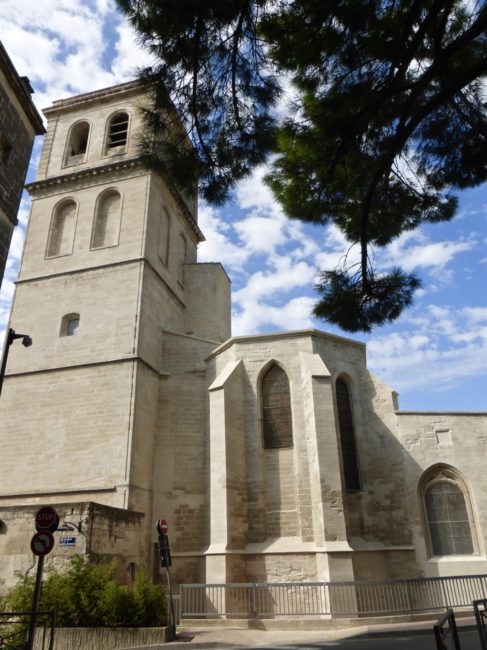 …and being gluttons for punishment we trudged back up to Cathédrale Notre Dame-des-Doms (the stairs were getting to me), where the nuptials were not finished.
…and being gluttons for punishment we trudged back up to Cathédrale Notre Dame-des-Doms (the stairs were getting to me), where the nuptials were not finished.
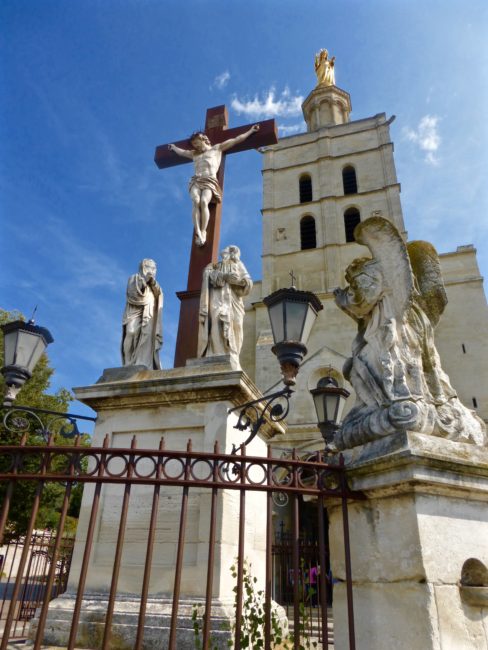 We pressed on even further up to Jardin du Rocher-des-Doms, a small park created in the 19th century. From one vantage point, we looked out over the famed Pont St. Bénezet, which at one point spanned the Rhône. Obviously built by the same people who construct California’s freeways, it was damaged beyond repair in 1660. Since we had already visited it once, we didn’t need to go again.
We pressed on even further up to Jardin du Rocher-des-Doms, a small park created in the 19th century. From one vantage point, we looked out over the famed Pont St. Bénezet, which at one point spanned the Rhône. Obviously built by the same people who construct California’s freeways, it was damaged beyond repair in 1660. Since we had already visited it once, we didn’t need to go again.
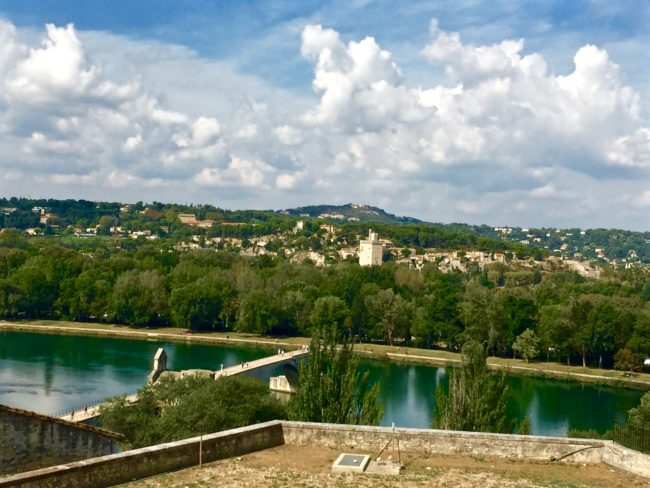 Walking through the park with a pond and a café, we opted to get out of dodge and head back toward toward a Luberon town we wanted to scope out.
Walking through the park with a pond and a café, we opted to get out of dodge and head back toward toward a Luberon town we wanted to scope out.
We must have been in a hurry, because I have received two speeding tickets since returning home.
The winding road up to Gordes afforded incredible views to another one of “The Most Beautiful Villages of France.” Tracy stuck her head outside the window as I drove slowly so she could take photos. We found out later there’s an easier way to perform this task.
The first parking lot (€2) was situated about 200 meters from the village, and we began our walk toward Gordes. It was here that I first felt a little weird (weirder than usual), but we pressed on. The war memorial commemorates residents of Gordes who were killed or went missing in World War I, World War II and the war in Algeria (1954-1962).
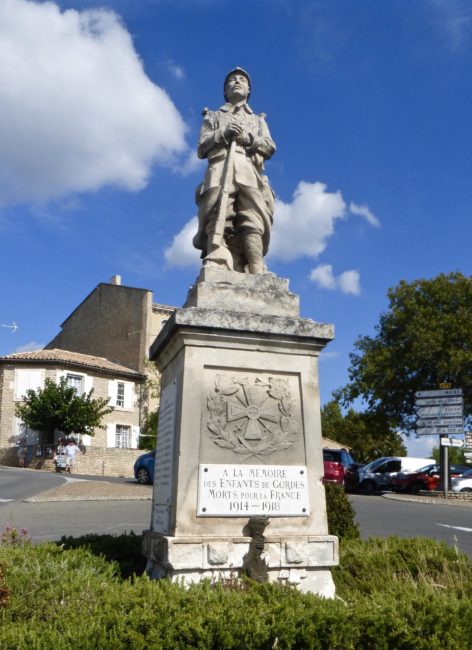 Reaching the center of Gordes, crowds had descended by 2:30 p.m. looking for its many restaurants and galleries. We passed by the castle…
Reaching the center of Gordes, crowds had descended by 2:30 p.m. looking for its many restaurants and galleries. We passed by the castle…
and some colorful produce before…
…popping into the very colorful Église Saint Firmin…
…a 12th-century Romanesque church…
…rebuilt in the 18th century.
There were some nice views from Gordes, but by now these views had become somewhat familiar. My favorite recollection from Gordes was the lavender glacé enjoyed on the walk back to the car.
Speaking of winding roads, we took another one on the way down to Abbaye Notre-Dame de Sénanque, which is the famous abbey you see in numerous photos, its colorful lavender adorning the fields in front of it. We turned off the one-way road, just as another car entered going in the wrong direction. We didn’t hear a crash, so hopefully all went well.
 Of course, being late September, the lavender had no color, but we still walked down from the parking lot to the abbey. I now wasn’t feeling great, but being an idiot I didn’t tell Tracy. The Cisterian abbey was founded in 1148.
Of course, being late September, the lavender had no color, but we still walked down from the parking lot to the abbey. I now wasn’t feeling great, but being an idiot I didn’t tell Tracy. The Cisterian abbey was founded in 1148.
 We stopped, took some photos, visited the gift shop and then made the walk back up to the car.
We stopped, took some photos, visited the gift shop and then made the walk back up to the car.
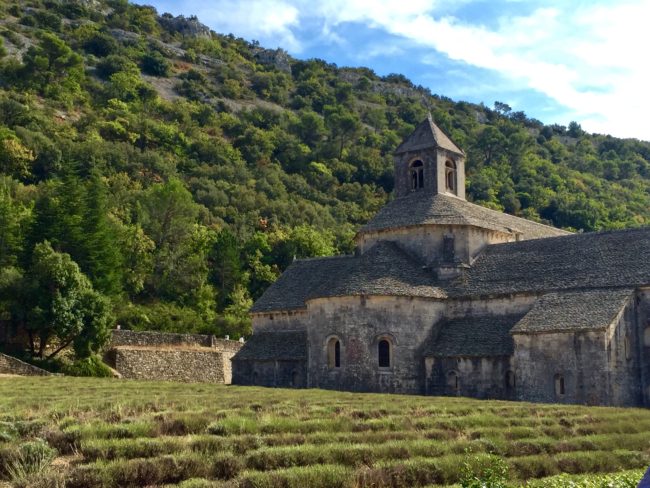 By now it was time to fess up. Outside of the chest pain, soreness in both arms and my heart racing faster than a sprinter, things were looking up. I said, “Tracy, you might want to drive. I’m not feeling so good. By the way, did they have a defibrillator in the gift shop?”
By now it was time to fess up. Outside of the chest pain, soreness in both arms and my heart racing faster than a sprinter, things were looking up. I said, “Tracy, you might want to drive. I’m not feeling so good. By the way, did they have a defibrillator in the gift shop?”
Tracy was worried what would happen if I had a heart attack now, since we didn’t really know the hospital situation throughout the Luberon. I was fairly certain I was just a little dehydrated (at least that’s what I hoped), which can cause these same symptoms Tracy took the wheel, I drank some water and by the time we were back near Gordes I was feeling somewhat better meaning Tracy would not have to peruse dating websites when she got back home. It was very exciting for Tracy (well not the heart attack thing) because on all of our European trips this was amazingly the first time she had ever driven.
 Up ahead we saw something we missed on the way in, a turnout to take photos of Gordes. Some of these pictures look like the hill town was super imposed behind us.
Up ahead we saw something we missed on the way in, a turnout to take photos of Gordes. Some of these pictures look like the hill town was super imposed behind us.
With Tracy still driving (once she gets her hands on the keys, I’m doomed), we drove to a town on the way back to Bonnieux. The twisting, winding road took us to Goult. Although pretty, there was little to do, and the inhabitants of this town must have fled, because we were mostly eerily alone. Where does everyone go?
Back at Terrasses du Luberon, we somehow had time for a little R&R and dipped our toes in the pool (I promised the establishment I wouldn’t take my shirt off so as to not scare the other guests) while sipping some wine. Wine is good for the heart, right?
Soon it was time to head out for one last dinner. Le Fournil is set inside a troglodytic cave and formerly served as the town bakery. It has a 17th-century fountain in front.
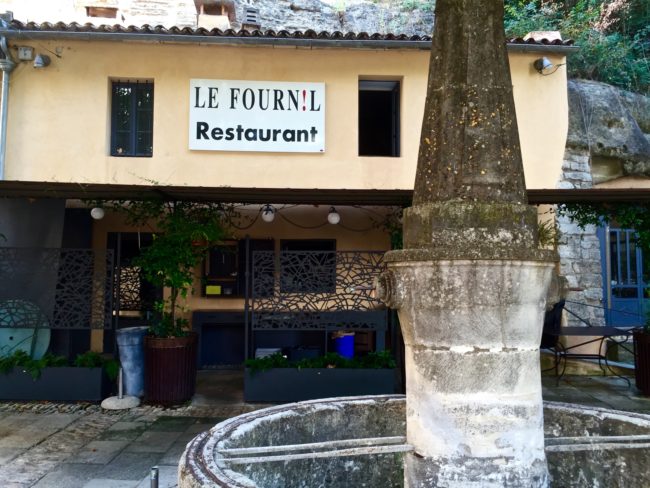 Our dinner started with an amuse bouche of chilled spinach soup with crème fraîche. Staying on the soup theme, I ordered a chilled white bean soup with celery and sautéed foie gras.
Our dinner started with an amuse bouche of chilled spinach soup with crème fraîche. Staying on the soup theme, I ordered a chilled white bean soup with celery and sautéed foie gras.
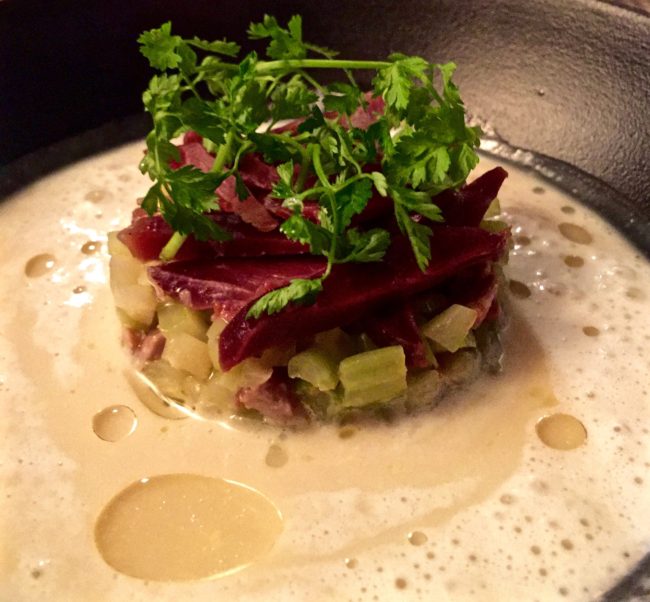 The veal was quite tasty, but, as usual, I felt guilty for eating it.
The veal was quite tasty, but, as usual, I felt guilty for eating it.
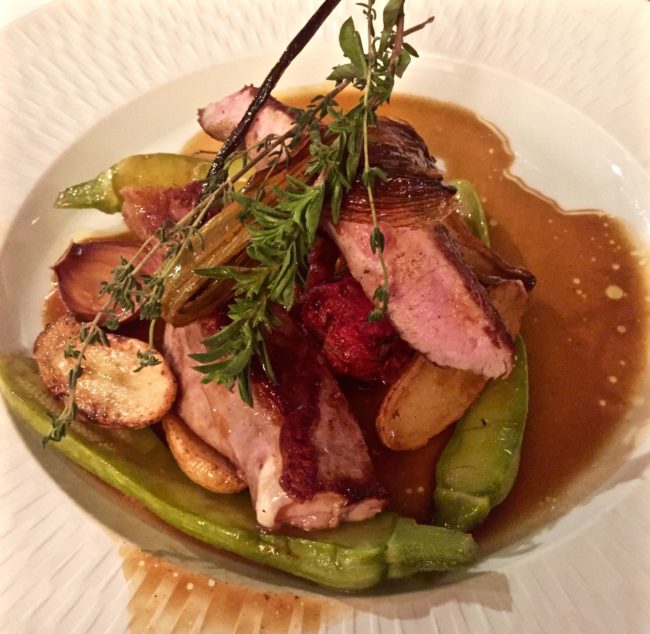 Tracy also had the soup and sea bass on a bed of risotto.
Tracy also had the soup and sea bass on a bed of risotto.
 We enjoyed all three restaurants in Bonnieux, and you can’t go wrong with any of them. Our rankings.
We enjoyed all three restaurants in Bonnieux, and you can’t go wrong with any of them. Our rankings.
L’Arôme
Restaurant Cesar
Le Fournil
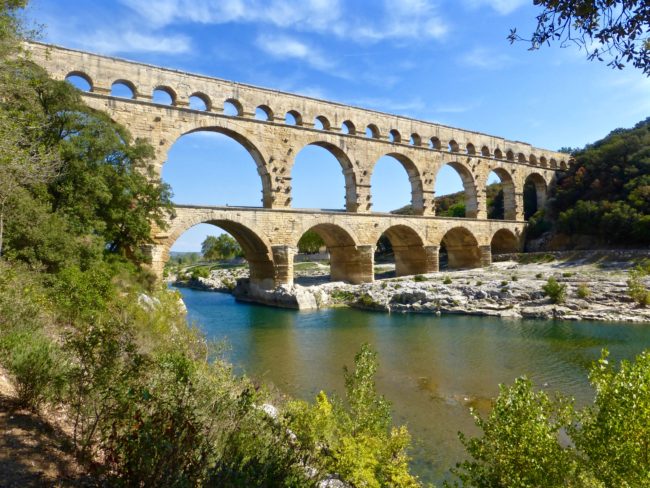 Back at our b&b it was time to pack and get ready for tomorrow’s drive. On our way to Uzés, we’d stop in a town to check out some water wheels, visit a marvel of ancient Rome, check in to our Uzés “castle,” visit a beautiful cathedral and have a terrific dinner under a lovely fig tree. Even a chance encounter with a group of people straight out of “Deliverance” proved interesting.
Back at our b&b it was time to pack and get ready for tomorrow’s drive. On our way to Uzés, we’d stop in a town to check out some water wheels, visit a marvel of ancient Rome, check in to our Uzés “castle,” visit a beautiful cathedral and have a terrific dinner under a lovely fig tree. Even a chance encounter with a group of people straight out of “Deliverance” proved interesting.
Next: Day Eight – Brexit Chat, Big Wheels, On Gard, Paging Ned Beatty, Circling Uzés, Always Best To Check Your Emails, Castle Keep, Leaning Tower Of Pisa, Patio Perfect and The “Important American”

